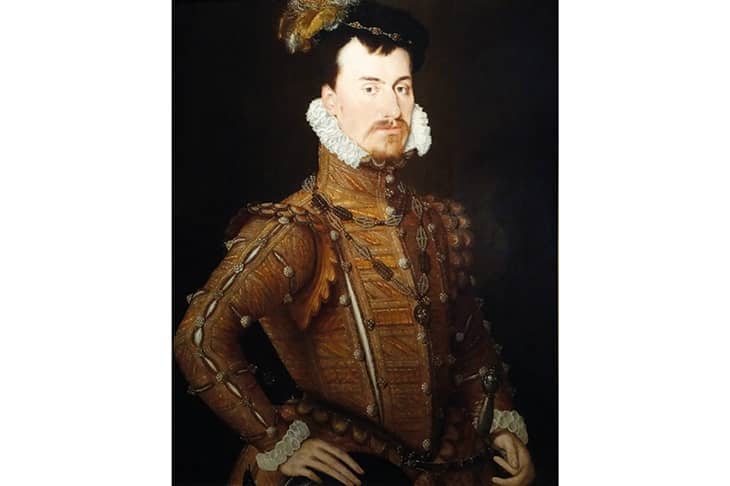This is the gripping story of the ever-fluctuating fortunes of three generations of the Dudley dynasty, servants to — and at times rivals for — the Crown in the 16th century. As Joanne Paul observes in her engrossing biography of an extraordinary family, ‘had fate, Fortuna, Nemesis or God made only the slightest adjustment to their orchestration of events’, the Dudleys, not the Tudors, might have ruled England for generations.
The narrative begins in the 1490s with Edmund Dudley, an Oxford-educated barrister who rose to a position of power, influence and wealth at the early Tudor court, only to be arrested and imprisoned in the Tower within days of Henry VII’s death in 1509. Conspired against by a cabal that included William Warham, Archbishop of Canterbury, and the teenaged Henry VIII, Edmund was convicted of treason and beheaded on Tower Hill.
His son John, a boy of five or six at the time of his father’s execution, was neither bowed nor broken by these events. As an adult, he successfully cultivated the favour of both Henry VIII, who created him Viscount Lisle, and of his successor, the malleable boy king Edward VI, who created him Earl of Warwick and Duke of Northumberland. After seeing off his great rival Edward Seymour, Duke of Somerset, Northumberland effectively ruled England from 1550 until his downfall three years later.
Robert Dudley was suspected of ordering his wife’s death to pave the way for marriage to Elizabeth I
When, in 1553, Edward VI fell mortally ill, Northumberland made an unsuccessful bid to divert the Crown away from Mary Tudor. First, he married off his youngest son, Guildford, to Lady Jane Grey. Then he persuaded — or certainly did not dissuade — the dying king that the 16-year-old Lady Jane Dudley, as she now was, be named his successor. This ploy ended in disaster for the Dudleys when Mary Tudor unexpectedly marshalled an army of supporters. John Dudley was stripped of his titles and, like his father before him, forfeited his possessions to the Crown, was imprisoned in the Tower and tried and convicted of treason. He was beheaded on 22 August. The following year, Guildford and Lady Jane met the same fate.
John Dudley’s other sons — John, Henry, Ambrose and Robert — escaped execution, thanks to the interventions of their mother Jane (née Guildford), one of several formidable women encountered in these pages. Nonetheless, the four brothers were forced to endure imprisonment in the Tower and the ignominy of attainder. John fell ill, and died in 1554 while in prison. Henry would be killed a few years later at the battle of St Quentin. Only Ambrose, created Earl of Warwick in 1561, and Robert, created Earl of Leicester in 1564, lived to see the family’s fortunes restored under Elizabeth I, who counted Robert as her favourite and, perhaps, as her lover. Certainly he seems to have been the only man she ever seriously considered marrying.
Almost from the moment Elizabeth ascended the throne, her friendship with the handsome but married Robert Dudley was a source of gossip. The Spanish ambassador reported just months into the new reign that the young queen was in the habit of visiting Dudley’s chamber day and night — waiting for his wife to die so that she might marry him herself. When, not long after, Amy Dudley (née Robsart) was found dead at the foot of a stone staircase, the rumour mill went into overdrive. A coroner’s court judged the death accidental. But Robert Dudley’s reputation was forever stained by the lingering suggestion that he had ordered his wife killed to pave the way for marriage to the queen — and kingship in all but name.
Elizabeth, of course, never married him or anyone else. But she showered him with titles, honours and grants of land and property. When in 1562 she fell ill with smallpox, she sought in the event of her death to have Robert appointed Protector of the Realm with a title and an income of £20,000, an eye-watering sum. Robert’s sister Mary (the mother of the poet Sir Philip Sidney), was also close to the queen, though her tasks were rather more thankless. She nursed Elizabeth through smallpox and in the process contracted the disease herself, and nearly died. Whereas the queen emerged scar-free, Mary was disfigured for life.
Like his father and grandfather, Robert Dudley had the monarch’s ear in a way that few courtiers did. But unlike his forebears, he managed to retain royal favour, despite the fact that lurid gossip and innuendo dogged him throughout his life. In 1574, while trying to persuade Elizabeth to marry him, he secretly married Douglas Howard, Lady Sheffield, who was carrying his child — though he would later deny its validity.
In 1578, Dudley again married in secret. This time it was binding, though the bride — Lettice, Dowager Countess of Essex (whose late husband was rumoured to have been poisoned by Dudley) — may have been pregnant, for she wore a loose-fitting gown. If so, she miscarried shortly after, though she did give birth to a healthy son three years later. Briefly envisioned by his father as a future suitor for Lady Arabella Stuart, one of several claimants to the throne, the boy died while still a toddler. Finally, as Paul notes, ‘the House of Dudley and the House of Tudor came to their end, almost at the same moment and for the same reason’: neither succeeded in producing a legitimate heir.
This is riveting stuff: death, desire, power and scandal. Paul has made the most of it, producing a well written and historically grounded page-turner, suitable for adaptation as a television miniseries. And why not? Game of Thrones looks tame compared with the real-life machinations of the Dudleys and the Tudors. House of Dudley anyone?






Comments